IT Infrastructure Report: Jambo Poa Company Network Redesign Proposal
VerifiedAdded on 2023/02/01
|14
|3608
|87
Report
AI Summary
This report analyzes the current IT infrastructure of Jambo Poa Company, a printing company with a branch in Sydney, and proposes a new network design to improve performance and security. The report details the geographical scope, employing a three-layered hierarchical network model with access, distribution, and core layers. It provides a logical design with eight LANs, IP addressing using Class B, and subnetting schemes. The report recommends cloud computing providers VMware and Microsoft Azure, highlighting their services and benefits for Jambo Poa. Additionally, it discusses techniques supporting virtualization and cloud computing, as well as dynamic cloud scaling to accommodate the company's growth. The report concludes with a summary of the proposed network design and its advantages.

IT Infrastructure
Student Name:
Subject:
Task:
Due Date:
Student Name:
Subject:
Task:
Due Date:
Paraphrase This Document
Need a fresh take? Get an instant paraphrase of this document with our AI Paraphraser
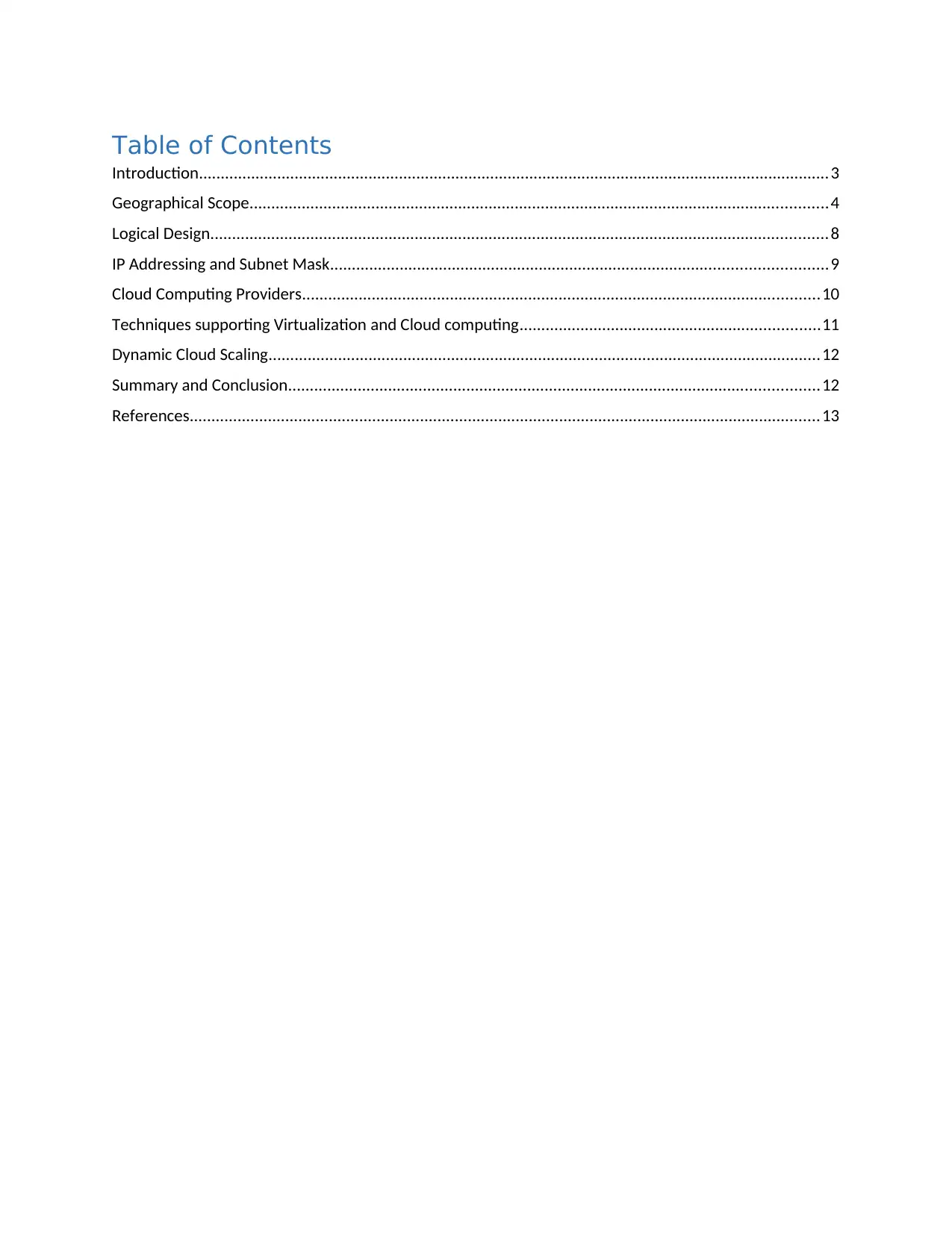
Table of Contents
Introduction.................................................................................................................................................3
Geographical Scope.....................................................................................................................................4
Logical Design..............................................................................................................................................8
IP Addressing and Subnet Mask..................................................................................................................9
Cloud Computing Providers.......................................................................................................................10
Techniques supporting Virtualization and Cloud computing.....................................................................11
Dynamic Cloud Scaling...............................................................................................................................12
Summary and Conclusion..........................................................................................................................12
References.................................................................................................................................................13
Introduction.................................................................................................................................................3
Geographical Scope.....................................................................................................................................4
Logical Design..............................................................................................................................................8
IP Addressing and Subnet Mask..................................................................................................................9
Cloud Computing Providers.......................................................................................................................10
Techniques supporting Virtualization and Cloud computing.....................................................................11
Dynamic Cloud Scaling...............................................................................................................................12
Summary and Conclusion..........................................................................................................................12
References.................................................................................................................................................13

Introduction
Network interconnectivity and usage has increasingly become one of the main integral part of
any functional organization in transacting their business activities. This therefore means that
organizations ought to have proper network models in place in order to support and keep their
businesses running.
This report focus will therefore be to analyse the current networking layout of Jambo Poa
Company and provide a proposal of how their new network should be in their new location at
Sydney City Centre. The report will look at the geographical scope of the network, provide
logical design and IP addressing scheme that the organization should use, cloud computing
service providers and how virtualization support dynamic scaling of the organization network in
cloud computing.
Case Study
Jambo Poa Limited is a printing company that is located at Sydney and whose business activities
relies mostly on the network. The company has 1200 workstations located across the entire
organization. In addition to the workstations the company has its data centre located within the
organization premise. Recently the company is planning to open a new branch at Sydney City
Centre in a building of 8 floors with each floor consisting of 30 rooms each having five
workstations. The company network currently consist of file, print, DHCP and DNS servers and
all these should now be configured to communicate with the new branch.
Current Network
This company’s current network is based on the flat networking model and not the three-layered
networking model.
Figure 1: Flat Network Design
This therefore means that all the networking devices operates within the same level. This has
been a challenge to the organization since it is difficult to extend their network and also adding
more devices to this network degrades the performance of the organizations network. The
security of this network is also not good due to poor design of the network. This therefore has
Network interconnectivity and usage has increasingly become one of the main integral part of
any functional organization in transacting their business activities. This therefore means that
organizations ought to have proper network models in place in order to support and keep their
businesses running.
This report focus will therefore be to analyse the current networking layout of Jambo Poa
Company and provide a proposal of how their new network should be in their new location at
Sydney City Centre. The report will look at the geographical scope of the network, provide
logical design and IP addressing scheme that the organization should use, cloud computing
service providers and how virtualization support dynamic scaling of the organization network in
cloud computing.
Case Study
Jambo Poa Limited is a printing company that is located at Sydney and whose business activities
relies mostly on the network. The company has 1200 workstations located across the entire
organization. In addition to the workstations the company has its data centre located within the
organization premise. Recently the company is planning to open a new branch at Sydney City
Centre in a building of 8 floors with each floor consisting of 30 rooms each having five
workstations. The company network currently consist of file, print, DHCP and DNS servers and
all these should now be configured to communicate with the new branch.
Current Network
This company’s current network is based on the flat networking model and not the three-layered
networking model.
Figure 1: Flat Network Design
This therefore means that all the networking devices operates within the same level. This has
been a challenge to the organization since it is difficult to extend their network and also adding
more devices to this network degrades the performance of the organizations network. The
security of this network is also not good due to poor design of the network. This therefore has
⊘ This is a preview!⊘
Do you want full access?
Subscribe today to unlock all pages.

Trusted by 1+ million students worldwide
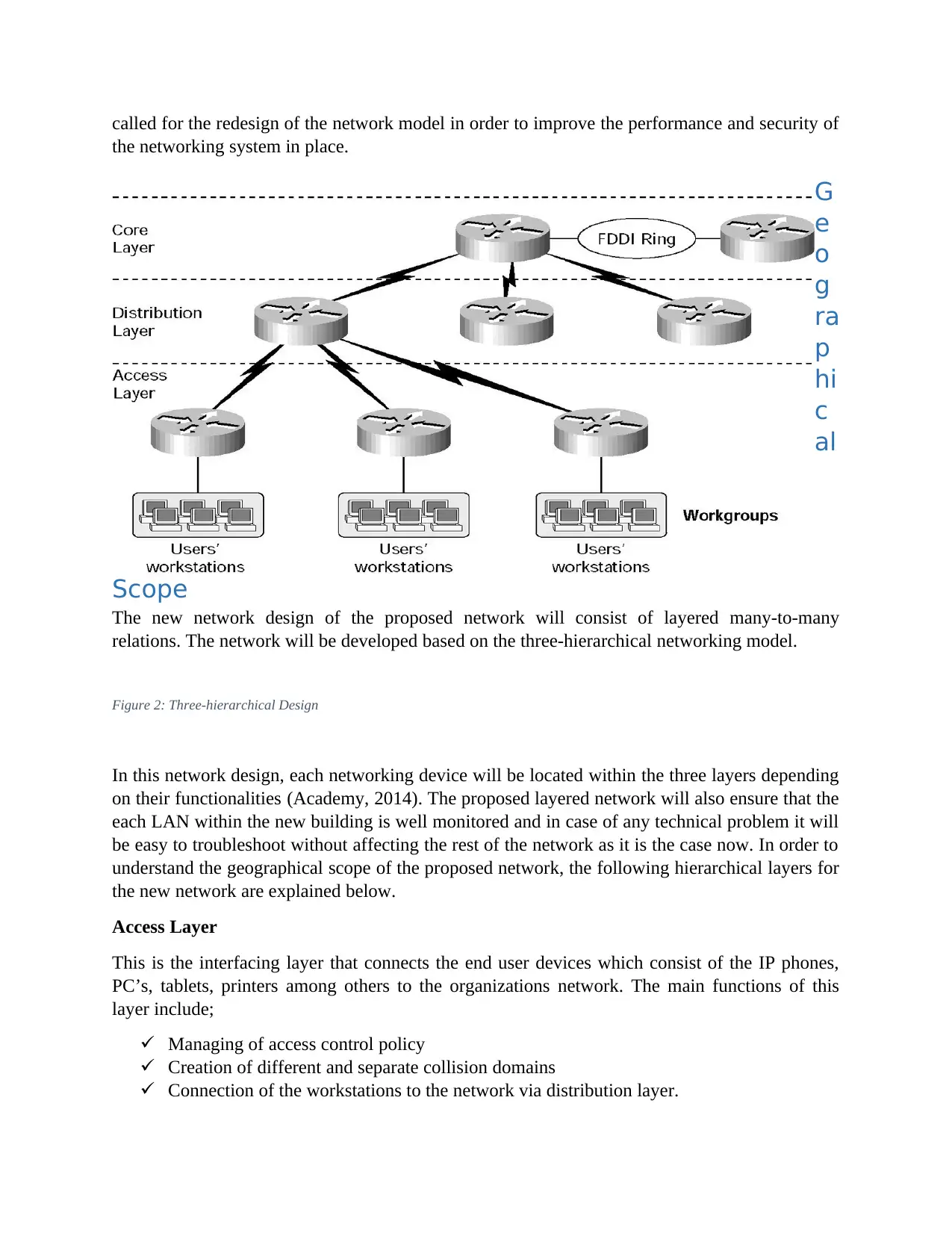
called for the redesign of the network model in order to improve the performance and security of
the networking system in place.
G
e
o
g
ra
p
hi
c
al
Scope
The new network design of the proposed network will consist of layered many-to-many
relations. The network will be developed based on the three-hierarchical networking model.
Figure 2: Three-hierarchical Design
In this network design, each networking device will be located within the three layers depending
on their functionalities (Academy, 2014). The proposed layered network will also ensure that the
each LAN within the new building is well monitored and in case of any technical problem it will
be easy to troubleshoot without affecting the rest of the network as it is the case now. In order to
understand the geographical scope of the proposed network, the following hierarchical layers for
the new network are explained below.
Access Layer
This is the interfacing layer that connects the end user devices which consist of the IP phones,
PC’s, tablets, printers among others to the organizations network. The main functions of this
layer include;
Managing of access control policy
Creation of different and separate collision domains
Connection of the workstations to the network via distribution layer.
the networking system in place.
G
e
o
g
ra
p
hi
c
al
Scope
The new network design of the proposed network will consist of layered many-to-many
relations. The network will be developed based on the three-hierarchical networking model.
Figure 2: Three-hierarchical Design
In this network design, each networking device will be located within the three layers depending
on their functionalities (Academy, 2014). The proposed layered network will also ensure that the
each LAN within the new building is well monitored and in case of any technical problem it will
be easy to troubleshoot without affecting the rest of the network as it is the case now. In order to
understand the geographical scope of the proposed network, the following hierarchical layers for
the new network are explained below.
Access Layer
This is the interfacing layer that connects the end user devices which consist of the IP phones,
PC’s, tablets, printers among others to the organizations network. The main functions of this
layer include;
Managing of access control policy
Creation of different and separate collision domains
Connection of the workstations to the network via distribution layer.
Paraphrase This Document
Need a fresh take? Get an instant paraphrase of this document with our AI Paraphraser
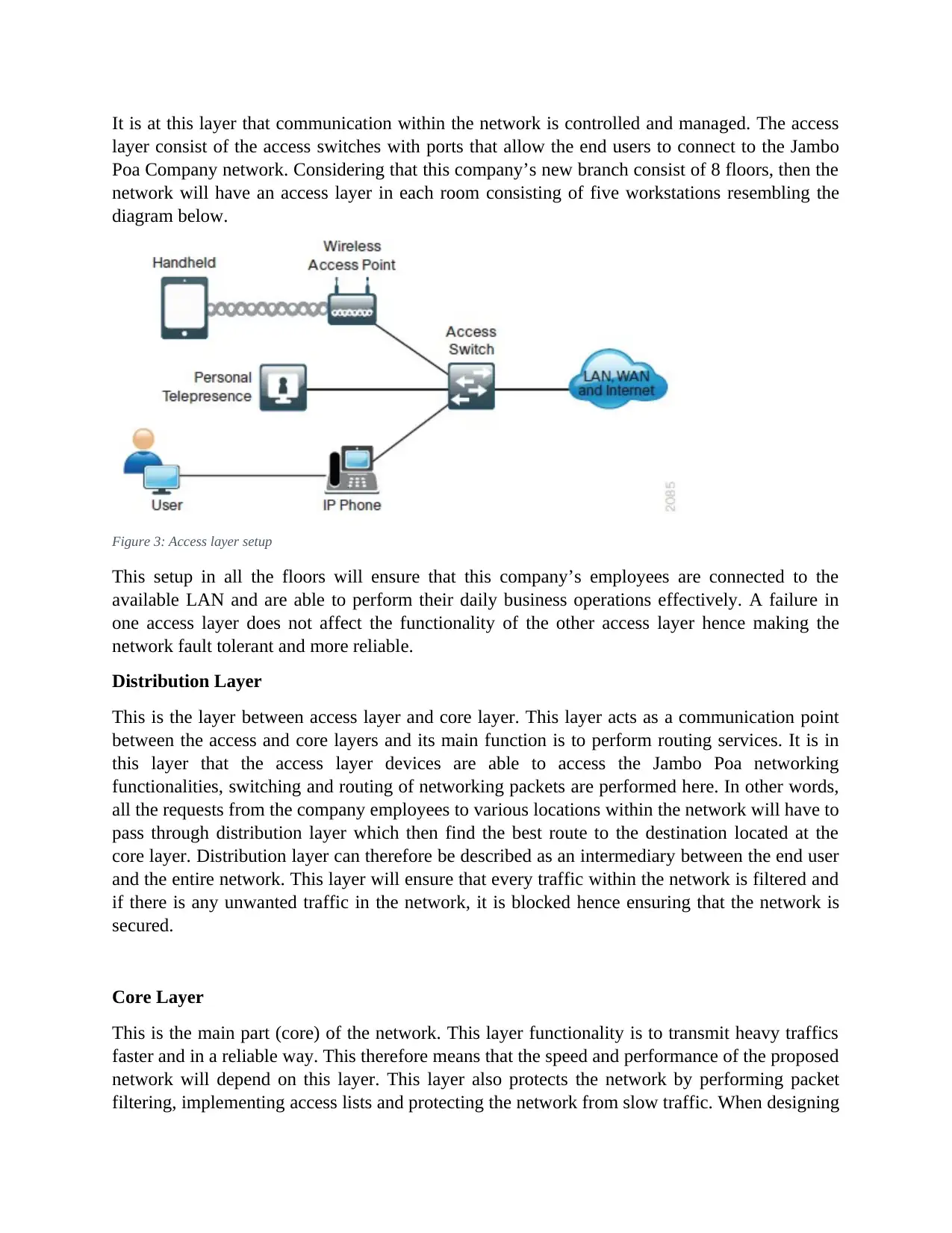
It is at this layer that communication within the network is controlled and managed. The access
layer consist of the access switches with ports that allow the end users to connect to the Jambo
Poa Company network. Considering that this company’s new branch consist of 8 floors, then the
network will have an access layer in each room consisting of five workstations resembling the
diagram below.
Figure 3: Access layer setup
This setup in all the floors will ensure that this company’s employees are connected to the
available LAN and are able to perform their daily business operations effectively. A failure in
one access layer does not affect the functionality of the other access layer hence making the
network fault tolerant and more reliable.
Distribution Layer
This is the layer between access layer and core layer. This layer acts as a communication point
between the access and core layers and its main function is to perform routing services. It is in
this layer that the access layer devices are able to access the Jambo Poa networking
functionalities, switching and routing of networking packets are performed here. In other words,
all the requests from the company employees to various locations within the network will have to
pass through distribution layer which then find the best route to the destination located at the
core layer. Distribution layer can therefore be described as an intermediary between the end user
and the entire network. This layer will ensure that every traffic within the network is filtered and
if there is any unwanted traffic in the network, it is blocked hence ensuring that the network is
secured.
Core Layer
This is the main part (core) of the network. This layer functionality is to transmit heavy traffics
faster and in a reliable way. This therefore means that the speed and performance of the proposed
network will depend on this layer. This layer also protects the network by performing packet
filtering, implementing access lists and protecting the network from slow traffic. When designing
layer consist of the access switches with ports that allow the end users to connect to the Jambo
Poa Company network. Considering that this company’s new branch consist of 8 floors, then the
network will have an access layer in each room consisting of five workstations resembling the
diagram below.
Figure 3: Access layer setup
This setup in all the floors will ensure that this company’s employees are connected to the
available LAN and are able to perform their daily business operations effectively. A failure in
one access layer does not affect the functionality of the other access layer hence making the
network fault tolerant and more reliable.
Distribution Layer
This is the layer between access layer and core layer. This layer acts as a communication point
between the access and core layers and its main function is to perform routing services. It is in
this layer that the access layer devices are able to access the Jambo Poa networking
functionalities, switching and routing of networking packets are performed here. In other words,
all the requests from the company employees to various locations within the network will have to
pass through distribution layer which then find the best route to the destination located at the
core layer. Distribution layer can therefore be described as an intermediary between the end user
and the entire network. This layer will ensure that every traffic within the network is filtered and
if there is any unwanted traffic in the network, it is blocked hence ensuring that the network is
secured.
Core Layer
This is the main part (core) of the network. This layer functionality is to transmit heavy traffics
faster and in a reliable way. This therefore means that the speed and performance of the proposed
network will depend on this layer. This layer also protects the network by performing packet
filtering, implementing access lists and protecting the network from slow traffic. When designing
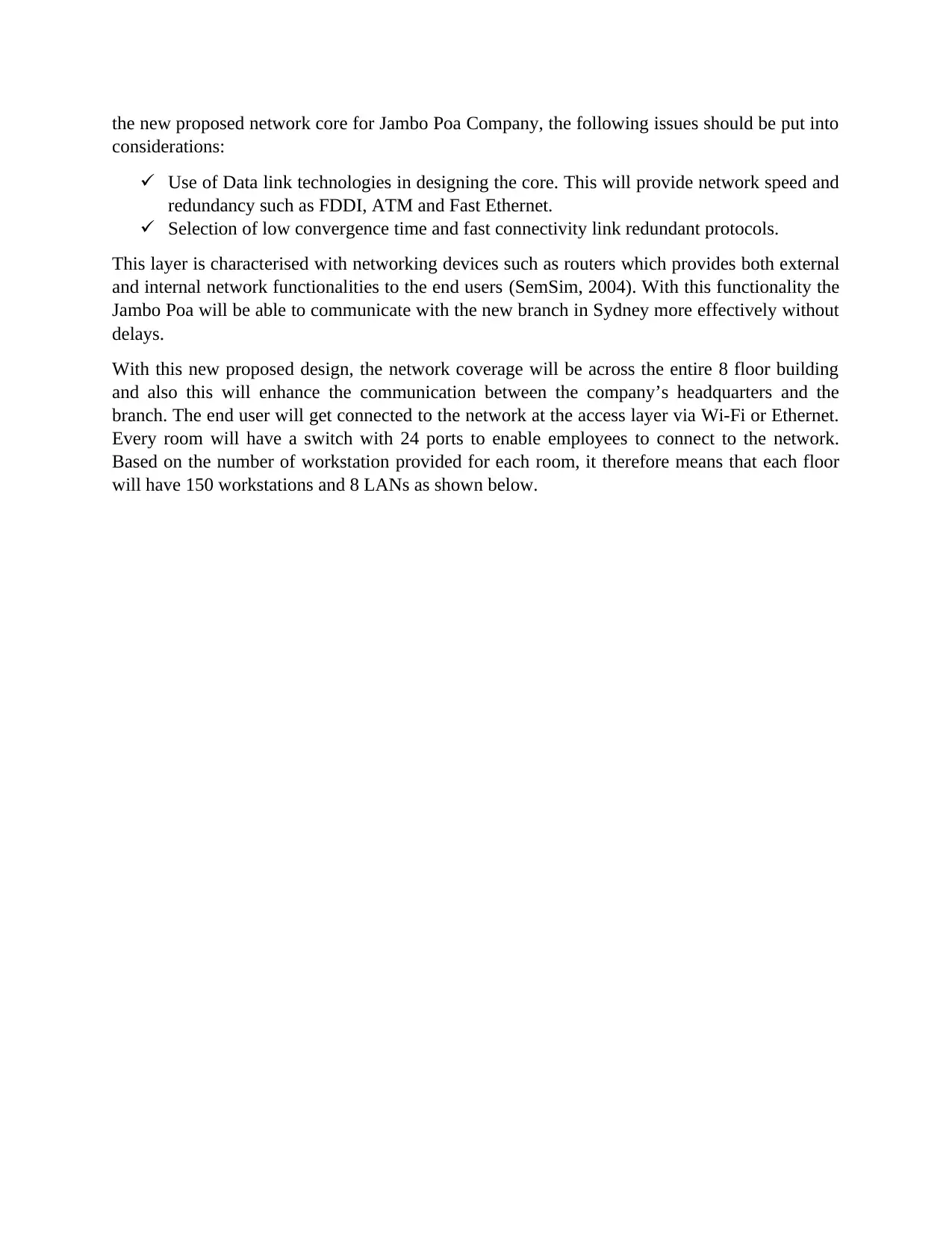
the new proposed network core for Jambo Poa Company, the following issues should be put into
considerations:
Use of Data link technologies in designing the core. This will provide network speed and
redundancy such as FDDI, ATM and Fast Ethernet.
Selection of low convergence time and fast connectivity link redundant protocols.
This layer is characterised with networking devices such as routers which provides both external
and internal network functionalities to the end users (SemSim, 2004). With this functionality the
Jambo Poa will be able to communicate with the new branch in Sydney more effectively without
delays.
With this new proposed design, the network coverage will be across the entire 8 floor building
and also this will enhance the communication between the company’s headquarters and the
branch. The end user will get connected to the network at the access layer via Wi-Fi or Ethernet.
Every room will have a switch with 24 ports to enable employees to connect to the network.
Based on the number of workstation provided for each room, it therefore means that each floor
will have 150 workstations and 8 LANs as shown below.
considerations:
Use of Data link technologies in designing the core. This will provide network speed and
redundancy such as FDDI, ATM and Fast Ethernet.
Selection of low convergence time and fast connectivity link redundant protocols.
This layer is characterised with networking devices such as routers which provides both external
and internal network functionalities to the end users (SemSim, 2004). With this functionality the
Jambo Poa will be able to communicate with the new branch in Sydney more effectively without
delays.
With this new proposed design, the network coverage will be across the entire 8 floor building
and also this will enhance the communication between the company’s headquarters and the
branch. The end user will get connected to the network at the access layer via Wi-Fi or Ethernet.
Every room will have a switch with 24 ports to enable employees to connect to the network.
Based on the number of workstation provided for each room, it therefore means that each floor
will have 150 workstations and 8 LANs as shown below.
⊘ This is a preview!⊘
Do you want full access?
Subscribe today to unlock all pages.

Trusted by 1+ million students worldwide
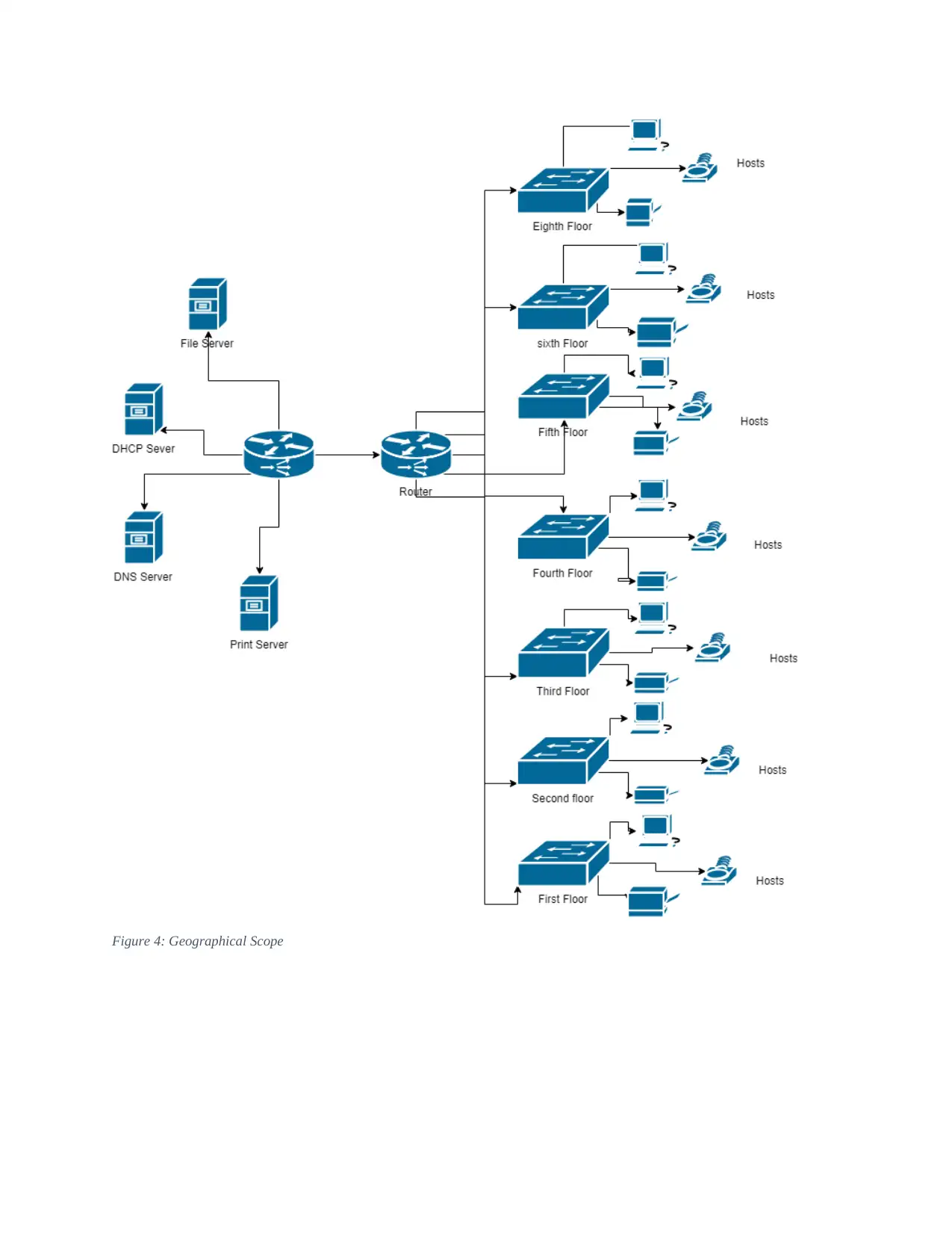
Figure 4: Geographical Scope
Paraphrase This Document
Need a fresh take? Get an instant paraphrase of this document with our AI Paraphraser
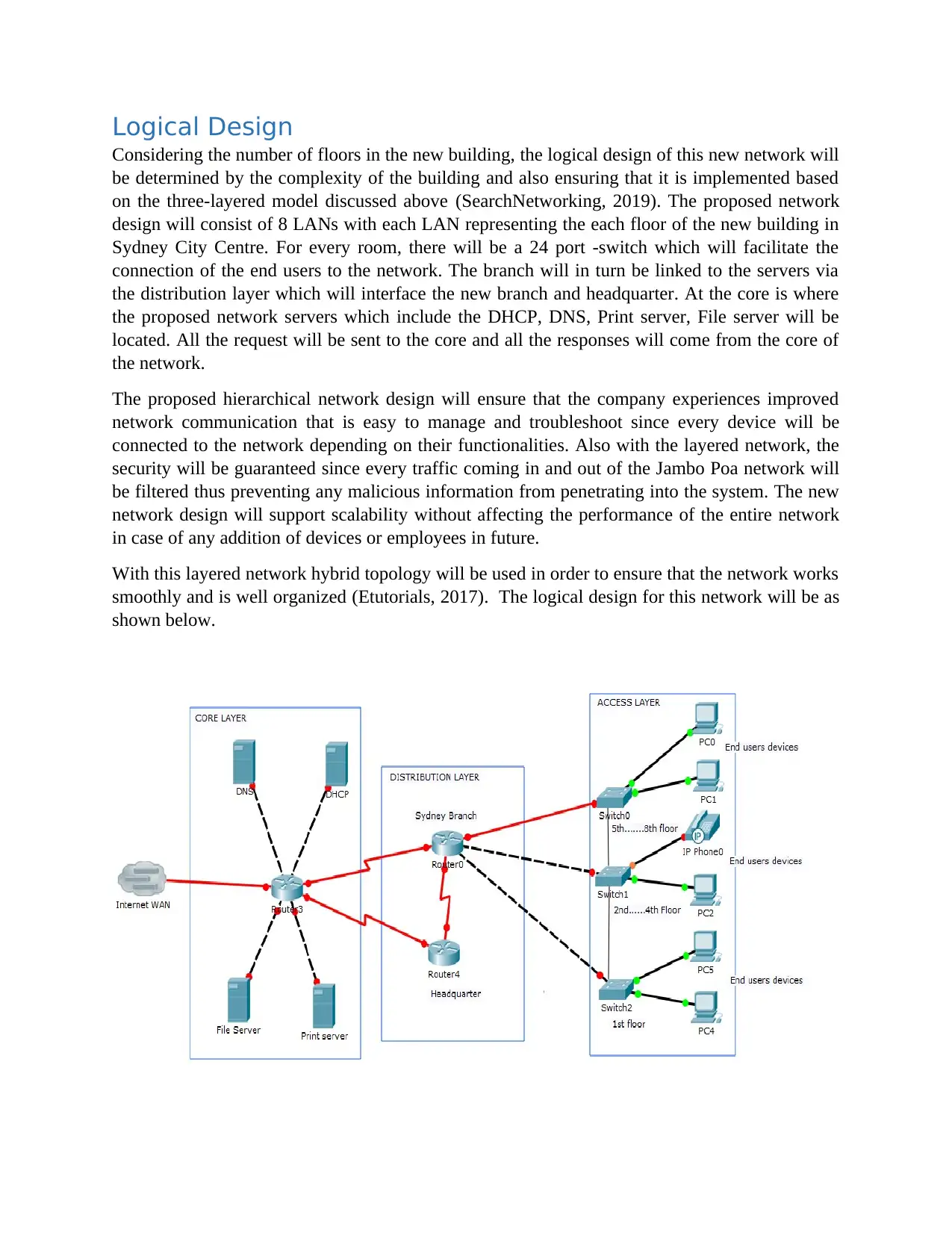
Logical Design
Considering the number of floors in the new building, the logical design of this new network will
be determined by the complexity of the building and also ensuring that it is implemented based
on the three-layered model discussed above (SearchNetworking, 2019). The proposed network
design will consist of 8 LANs with each LAN representing the each floor of the new building in
Sydney City Centre. For every room, there will be a 24 port -switch which will facilitate the
connection of the end users to the network. The branch will in turn be linked to the servers via
the distribution layer which will interface the new branch and headquarter. At the core is where
the proposed network servers which include the DHCP, DNS, Print server, File server will be
located. All the request will be sent to the core and all the responses will come from the core of
the network.
The proposed hierarchical network design will ensure that the company experiences improved
network communication that is easy to manage and troubleshoot since every device will be
connected to the network depending on their functionalities. Also with the layered network, the
security will be guaranteed since every traffic coming in and out of the Jambo Poa network will
be filtered thus preventing any malicious information from penetrating into the system. The new
network design will support scalability without affecting the performance of the entire network
in case of any addition of devices or employees in future.
With this layered network hybrid topology will be used in order to ensure that the network works
smoothly and is well organized (Etutorials, 2017). The logical design for this network will be as
shown below.
Considering the number of floors in the new building, the logical design of this new network will
be determined by the complexity of the building and also ensuring that it is implemented based
on the three-layered model discussed above (SearchNetworking, 2019). The proposed network
design will consist of 8 LANs with each LAN representing the each floor of the new building in
Sydney City Centre. For every room, there will be a 24 port -switch which will facilitate the
connection of the end users to the network. The branch will in turn be linked to the servers via
the distribution layer which will interface the new branch and headquarter. At the core is where
the proposed network servers which include the DHCP, DNS, Print server, File server will be
located. All the request will be sent to the core and all the responses will come from the core of
the network.
The proposed hierarchical network design will ensure that the company experiences improved
network communication that is easy to manage and troubleshoot since every device will be
connected to the network depending on their functionalities. Also with the layered network, the
security will be guaranteed since every traffic coming in and out of the Jambo Poa network will
be filtered thus preventing any malicious information from penetrating into the system. The new
network design will support scalability without affecting the performance of the entire network
in case of any addition of devices or employees in future.
With this layered network hybrid topology will be used in order to ensure that the network works
smoothly and is well organized (Etutorials, 2017). The logical design for this network will be as
shown below.
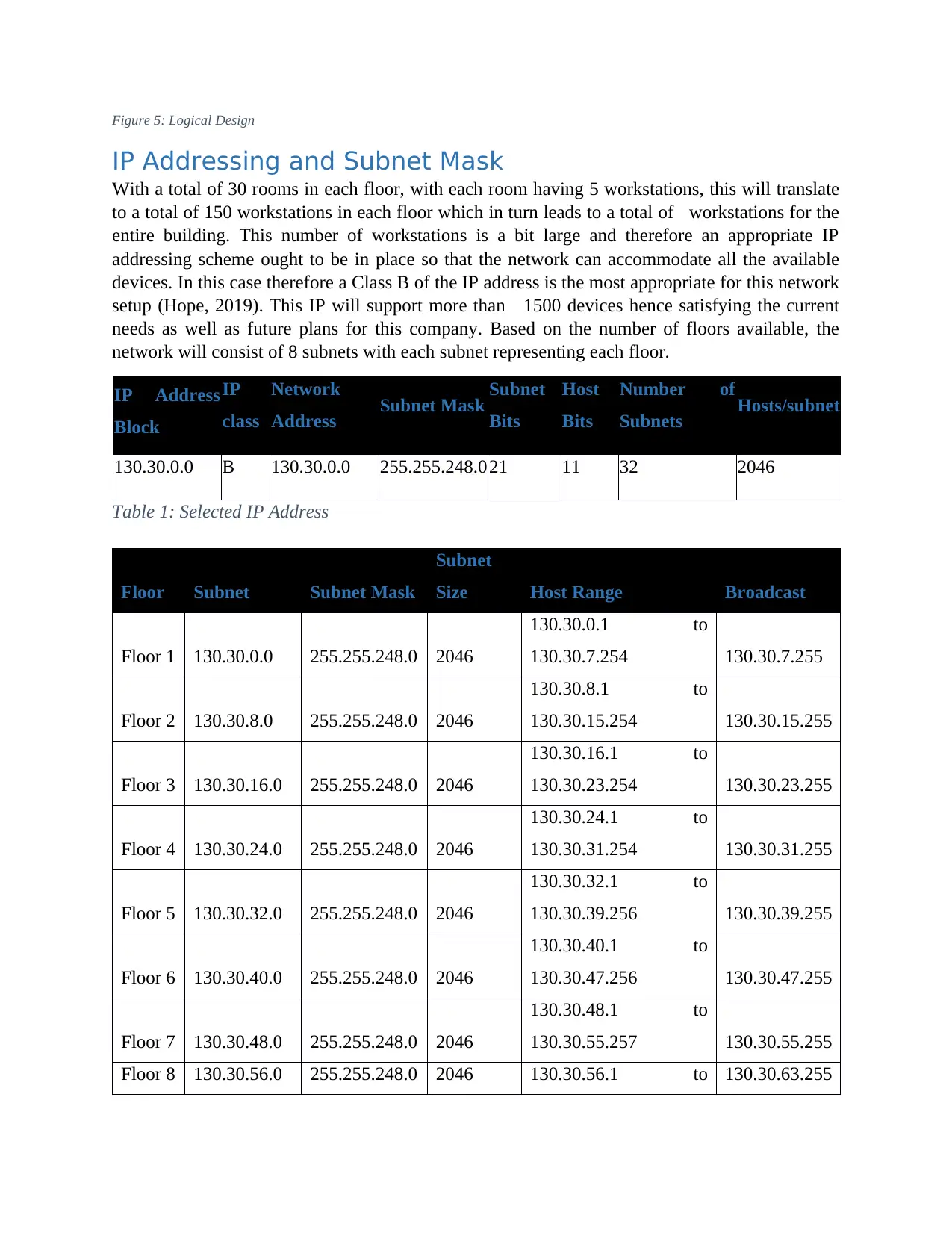
Figure 5: Logical Design
IP Addressing and Subnet Mask
With a total of 30 rooms in each floor, with each room having 5 workstations, this will translate
to a total of 150 workstations in each floor which in turn leads to a total of workstations for the
entire building. This number of workstations is a bit large and therefore an appropriate IP
addressing scheme ought to be in place so that the network can accommodate all the available
devices. In this case therefore a Class B of the IP address is the most appropriate for this network
setup (Hope, 2019). This IP will support more than 1500 devices hence satisfying the current
needs as well as future plans for this company. Based on the number of floors available, the
network will consist of 8 subnets with each subnet representing each floor.
IP Address
Block
IP
class
Network
Address Subnet Mask Subnet
Bits
Host
Bits
Number of
Subnets Hosts/subnet
130.30.0.0 B 130.30.0.0 255.255.248.0 21 11 32 2046
Table 1: Selected IP Address
Floor Subnet Subnet Mask
Subnet
Size Host Range Broadcast
Floor 1 130.30.0.0 255.255.248.0 2046
130.30.0.1 to
130.30.7.254 130.30.7.255
Floor 2 130.30.8.0 255.255.248.0 2046
130.30.8.1 to
130.30.15.254 130.30.15.255
Floor 3 130.30.16.0 255.255.248.0 2046
130.30.16.1 to
130.30.23.254 130.30.23.255
Floor 4 130.30.24.0 255.255.248.0 2046
130.30.24.1 to
130.30.31.254 130.30.31.255
Floor 5 130.30.32.0 255.255.248.0 2046
130.30.32.1 to
130.30.39.256 130.30.39.255
Floor 6 130.30.40.0 255.255.248.0 2046
130.30.40.1 to
130.30.47.256 130.30.47.255
Floor 7 130.30.48.0 255.255.248.0 2046
130.30.48.1 to
130.30.55.257 130.30.55.255
Floor 8 130.30.56.0 255.255.248.0 2046 130.30.56.1 to 130.30.63.255
IP Addressing and Subnet Mask
With a total of 30 rooms in each floor, with each room having 5 workstations, this will translate
to a total of 150 workstations in each floor which in turn leads to a total of workstations for the
entire building. This number of workstations is a bit large and therefore an appropriate IP
addressing scheme ought to be in place so that the network can accommodate all the available
devices. In this case therefore a Class B of the IP address is the most appropriate for this network
setup (Hope, 2019). This IP will support more than 1500 devices hence satisfying the current
needs as well as future plans for this company. Based on the number of floors available, the
network will consist of 8 subnets with each subnet representing each floor.
IP Address
Block
IP
class
Network
Address Subnet Mask Subnet
Bits
Host
Bits
Number of
Subnets Hosts/subnet
130.30.0.0 B 130.30.0.0 255.255.248.0 21 11 32 2046
Table 1: Selected IP Address
Floor Subnet Subnet Mask
Subnet
Size Host Range Broadcast
Floor 1 130.30.0.0 255.255.248.0 2046
130.30.0.1 to
130.30.7.254 130.30.7.255
Floor 2 130.30.8.0 255.255.248.0 2046
130.30.8.1 to
130.30.15.254 130.30.15.255
Floor 3 130.30.16.0 255.255.248.0 2046
130.30.16.1 to
130.30.23.254 130.30.23.255
Floor 4 130.30.24.0 255.255.248.0 2046
130.30.24.1 to
130.30.31.254 130.30.31.255
Floor 5 130.30.32.0 255.255.248.0 2046
130.30.32.1 to
130.30.39.256 130.30.39.255
Floor 6 130.30.40.0 255.255.248.0 2046
130.30.40.1 to
130.30.47.256 130.30.47.255
Floor 7 130.30.48.0 255.255.248.0 2046
130.30.48.1 to
130.30.55.257 130.30.55.255
Floor 8 130.30.56.0 255.255.248.0 2046 130.30.56.1 to 130.30.63.255
⊘ This is a preview!⊘
Do you want full access?
Subscribe today to unlock all pages.

Trusted by 1+ million students worldwide
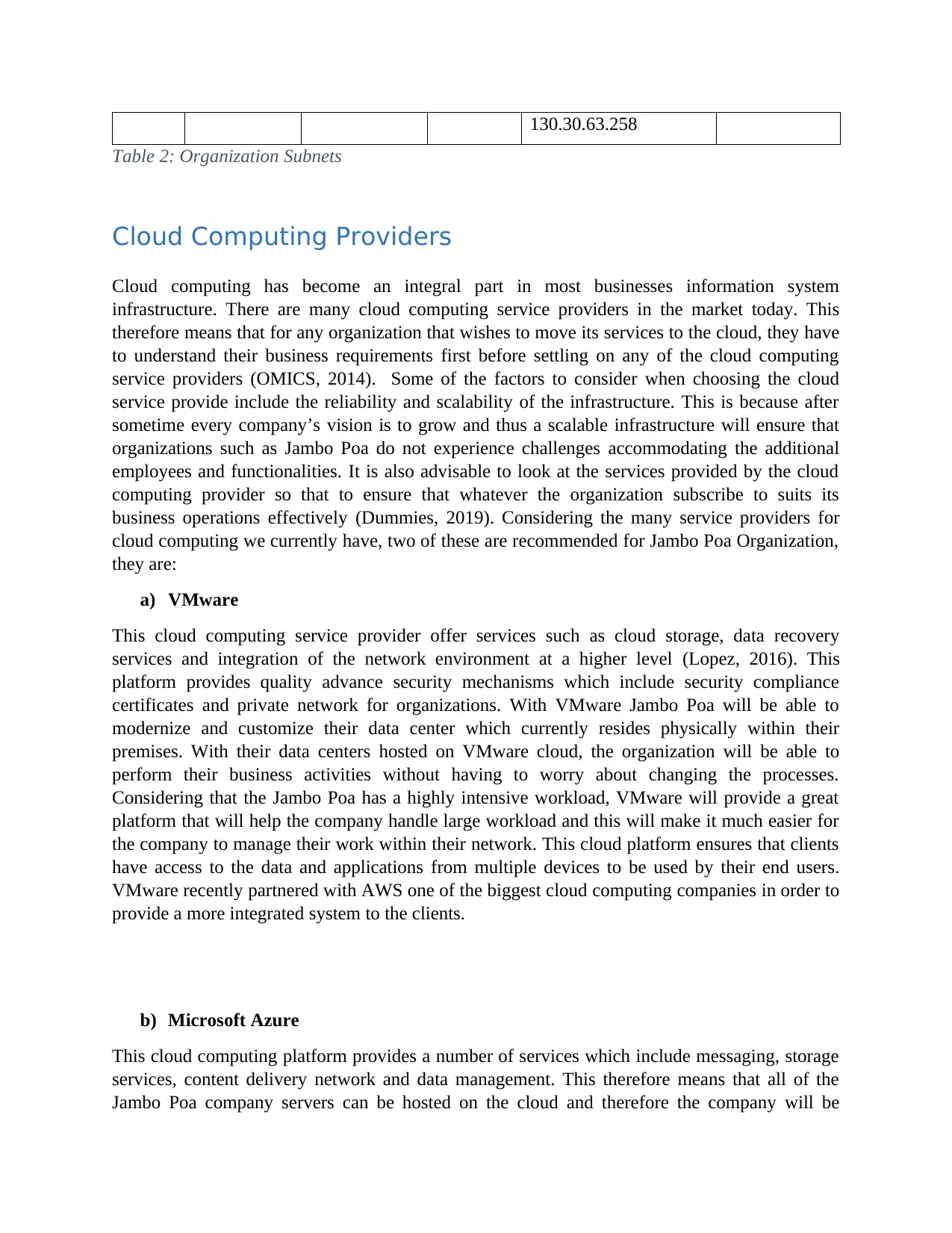
130.30.63.258
Table 2: Organization Subnets
Cloud Computing Providers
Cloud computing has become an integral part in most businesses information system
infrastructure. There are many cloud computing service providers in the market today. This
therefore means that for any organization that wishes to move its services to the cloud, they have
to understand their business requirements first before settling on any of the cloud computing
service providers (OMICS, 2014). Some of the factors to consider when choosing the cloud
service provide include the reliability and scalability of the infrastructure. This is because after
sometime every company’s vision is to grow and thus a scalable infrastructure will ensure that
organizations such as Jambo Poa do not experience challenges accommodating the additional
employees and functionalities. It is also advisable to look at the services provided by the cloud
computing provider so that to ensure that whatever the organization subscribe to suits its
business operations effectively (Dummies, 2019). Considering the many service providers for
cloud computing we currently have, two of these are recommended for Jambo Poa Organization,
they are:
a) VMware
This cloud computing service provider offer services such as cloud storage, data recovery
services and integration of the network environment at a higher level (Lopez, 2016). This
platform provides quality advance security mechanisms which include security compliance
certificates and private network for organizations. With VMware Jambo Poa will be able to
modernize and customize their data center which currently resides physically within their
premises. With their data centers hosted on VMware cloud, the organization will be able to
perform their business activities without having to worry about changing the processes.
Considering that the Jambo Poa has a highly intensive workload, VMware will provide a great
platform that will help the company handle large workload and this will make it much easier for
the company to manage their work within their network. This cloud platform ensures that clients
have access to the data and applications from multiple devices to be used by their end users.
VMware recently partnered with AWS one of the biggest cloud computing companies in order to
provide a more integrated system to the clients.
b) Microsoft Azure
This cloud computing platform provides a number of services which include messaging, storage
services, content delivery network and data management. This therefore means that all of the
Jambo Poa company servers can be hosted on the cloud and therefore the company will be
Table 2: Organization Subnets
Cloud Computing Providers
Cloud computing has become an integral part in most businesses information system
infrastructure. There are many cloud computing service providers in the market today. This
therefore means that for any organization that wishes to move its services to the cloud, they have
to understand their business requirements first before settling on any of the cloud computing
service providers (OMICS, 2014). Some of the factors to consider when choosing the cloud
service provide include the reliability and scalability of the infrastructure. This is because after
sometime every company’s vision is to grow and thus a scalable infrastructure will ensure that
organizations such as Jambo Poa do not experience challenges accommodating the additional
employees and functionalities. It is also advisable to look at the services provided by the cloud
computing provider so that to ensure that whatever the organization subscribe to suits its
business operations effectively (Dummies, 2019). Considering the many service providers for
cloud computing we currently have, two of these are recommended for Jambo Poa Organization,
they are:
a) VMware
This cloud computing service provider offer services such as cloud storage, data recovery
services and integration of the network environment at a higher level (Lopez, 2016). This
platform provides quality advance security mechanisms which include security compliance
certificates and private network for organizations. With VMware Jambo Poa will be able to
modernize and customize their data center which currently resides physically within their
premises. With their data centers hosted on VMware cloud, the organization will be able to
perform their business activities without having to worry about changing the processes.
Considering that the Jambo Poa has a highly intensive workload, VMware will provide a great
platform that will help the company handle large workload and this will make it much easier for
the company to manage their work within their network. This cloud platform ensures that clients
have access to the data and applications from multiple devices to be used by their end users.
VMware recently partnered with AWS one of the biggest cloud computing companies in order to
provide a more integrated system to the clients.
b) Microsoft Azure
This cloud computing platform provides a number of services which include messaging, storage
services, content delivery network and data management. This therefore means that all of the
Jambo Poa company servers can be hosted on the cloud and therefore the company will be
Paraphrase This Document
Need a fresh take? Get an instant paraphrase of this document with our AI Paraphraser
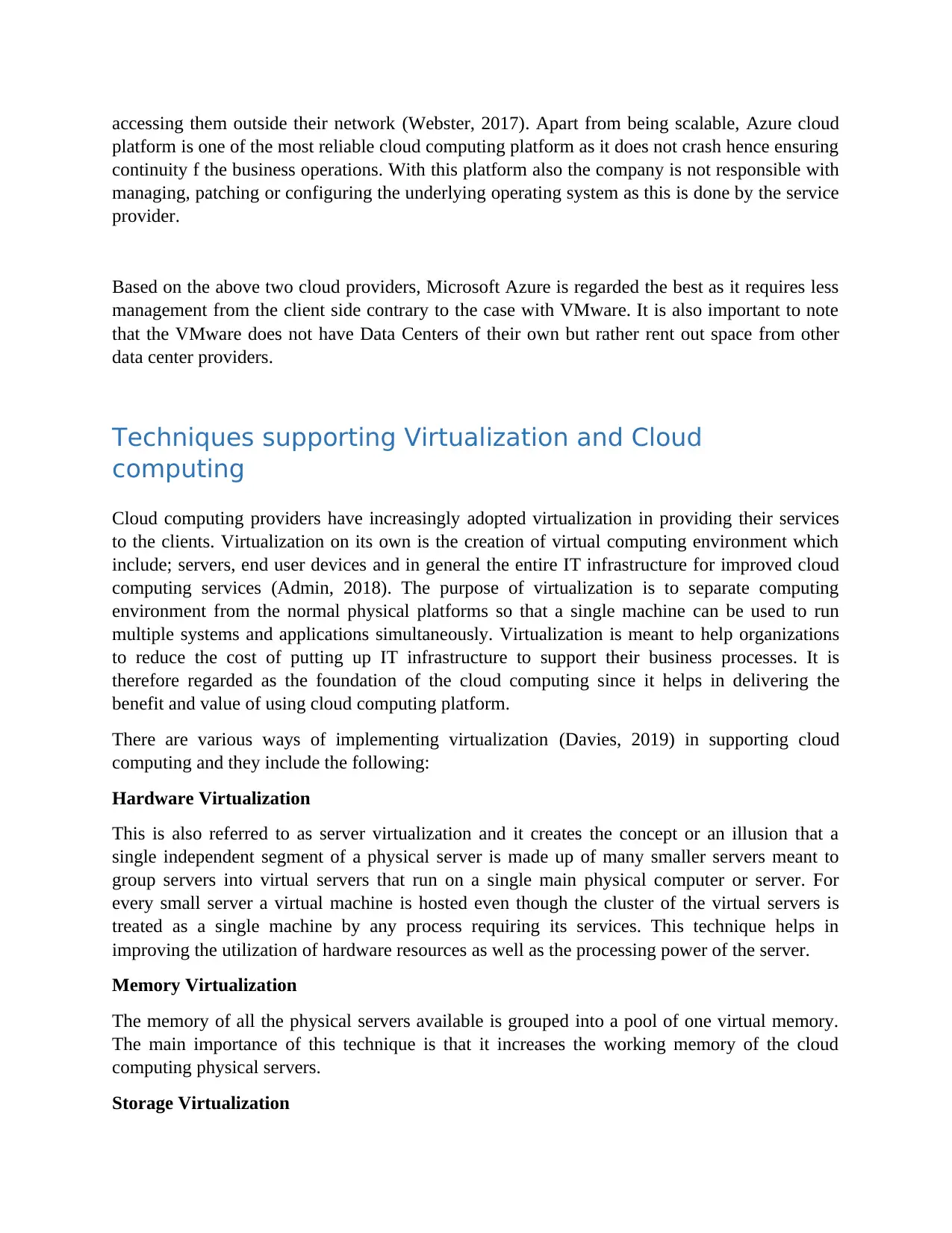
accessing them outside their network (Webster, 2017). Apart from being scalable, Azure cloud
platform is one of the most reliable cloud computing platform as it does not crash hence ensuring
continuity f the business operations. With this platform also the company is not responsible with
managing, patching or configuring the underlying operating system as this is done by the service
provider.
Based on the above two cloud providers, Microsoft Azure is regarded the best as it requires less
management from the client side contrary to the case with VMware. It is also important to note
that the VMware does not have Data Centers of their own but rather rent out space from other
data center providers.
Techniques supporting Virtualization and Cloud
computing
Cloud computing providers have increasingly adopted virtualization in providing their services
to the clients. Virtualization on its own is the creation of virtual computing environment which
include; servers, end user devices and in general the entire IT infrastructure for improved cloud
computing services (Admin, 2018). The purpose of virtualization is to separate computing
environment from the normal physical platforms so that a single machine can be used to run
multiple systems and applications simultaneously. Virtualization is meant to help organizations
to reduce the cost of putting up IT infrastructure to support their business processes. It is
therefore regarded as the foundation of the cloud computing since it helps in delivering the
benefit and value of using cloud computing platform.
There are various ways of implementing virtualization (Davies, 2019) in supporting cloud
computing and they include the following:
Hardware Virtualization
This is also referred to as server virtualization and it creates the concept or an illusion that a
single independent segment of a physical server is made up of many smaller servers meant to
group servers into virtual servers that run on a single main physical computer or server. For
every small server a virtual machine is hosted even though the cluster of the virtual servers is
treated as a single machine by any process requiring its services. This technique helps in
improving the utilization of hardware resources as well as the processing power of the server.
Memory Virtualization
The memory of all the physical servers available is grouped into a pool of one virtual memory.
The main importance of this technique is that it increases the working memory of the cloud
computing physical servers.
Storage Virtualization
platform is one of the most reliable cloud computing platform as it does not crash hence ensuring
continuity f the business operations. With this platform also the company is not responsible with
managing, patching or configuring the underlying operating system as this is done by the service
provider.
Based on the above two cloud providers, Microsoft Azure is regarded the best as it requires less
management from the client side contrary to the case with VMware. It is also important to note
that the VMware does not have Data Centers of their own but rather rent out space from other
data center providers.
Techniques supporting Virtualization and Cloud
computing
Cloud computing providers have increasingly adopted virtualization in providing their services
to the clients. Virtualization on its own is the creation of virtual computing environment which
include; servers, end user devices and in general the entire IT infrastructure for improved cloud
computing services (Admin, 2018). The purpose of virtualization is to separate computing
environment from the normal physical platforms so that a single machine can be used to run
multiple systems and applications simultaneously. Virtualization is meant to help organizations
to reduce the cost of putting up IT infrastructure to support their business processes. It is
therefore regarded as the foundation of the cloud computing since it helps in delivering the
benefit and value of using cloud computing platform.
There are various ways of implementing virtualization (Davies, 2019) in supporting cloud
computing and they include the following:
Hardware Virtualization
This is also referred to as server virtualization and it creates the concept or an illusion that a
single independent segment of a physical server is made up of many smaller servers meant to
group servers into virtual servers that run on a single main physical computer or server. For
every small server a virtual machine is hosted even though the cluster of the virtual servers is
treated as a single machine by any process requiring its services. This technique helps in
improving the utilization of hardware resources as well as the processing power of the server.
Memory Virtualization
The memory of all the physical servers available is grouped into a pool of one virtual memory.
The main importance of this technique is that it increases the working memory of the cloud
computing physical servers.
Storage Virtualization
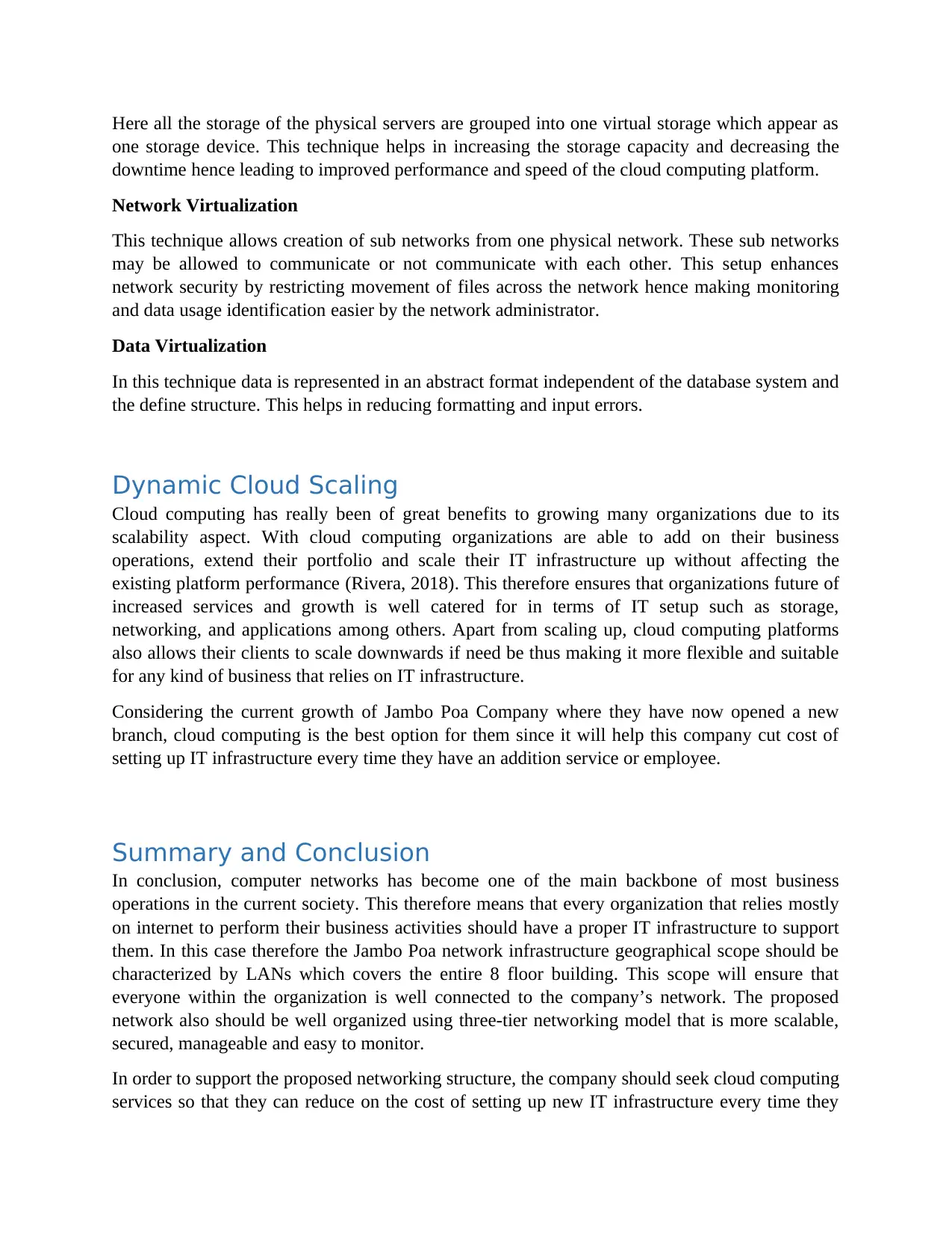
Here all the storage of the physical servers are grouped into one virtual storage which appear as
one storage device. This technique helps in increasing the storage capacity and decreasing the
downtime hence leading to improved performance and speed of the cloud computing platform.
Network Virtualization
This technique allows creation of sub networks from one physical network. These sub networks
may be allowed to communicate or not communicate with each other. This setup enhances
network security by restricting movement of files across the network hence making monitoring
and data usage identification easier by the network administrator.
Data Virtualization
In this technique data is represented in an abstract format independent of the database system and
the define structure. This helps in reducing formatting and input errors.
Dynamic Cloud Scaling
Cloud computing has really been of great benefits to growing many organizations due to its
scalability aspect. With cloud computing organizations are able to add on their business
operations, extend their portfolio and scale their IT infrastructure up without affecting the
existing platform performance (Rivera, 2018). This therefore ensures that organizations future of
increased services and growth is well catered for in terms of IT setup such as storage,
networking, and applications among others. Apart from scaling up, cloud computing platforms
also allows their clients to scale downwards if need be thus making it more flexible and suitable
for any kind of business that relies on IT infrastructure.
Considering the current growth of Jambo Poa Company where they have now opened a new
branch, cloud computing is the best option for them since it will help this company cut cost of
setting up IT infrastructure every time they have an addition service or employee.
Summary and Conclusion
In conclusion, computer networks has become one of the main backbone of most business
operations in the current society. This therefore means that every organization that relies mostly
on internet to perform their business activities should have a proper IT infrastructure to support
them. In this case therefore the Jambo Poa network infrastructure geographical scope should be
characterized by LANs which covers the entire 8 floor building. This scope will ensure that
everyone within the organization is well connected to the company’s network. The proposed
network also should be well organized using three-tier networking model that is more scalable,
secured, manageable and easy to monitor.
In order to support the proposed networking structure, the company should seek cloud computing
services so that they can reduce on the cost of setting up new IT infrastructure every time they
one storage device. This technique helps in increasing the storage capacity and decreasing the
downtime hence leading to improved performance and speed of the cloud computing platform.
Network Virtualization
This technique allows creation of sub networks from one physical network. These sub networks
may be allowed to communicate or not communicate with each other. This setup enhances
network security by restricting movement of files across the network hence making monitoring
and data usage identification easier by the network administrator.
Data Virtualization
In this technique data is represented in an abstract format independent of the database system and
the define structure. This helps in reducing formatting and input errors.
Dynamic Cloud Scaling
Cloud computing has really been of great benefits to growing many organizations due to its
scalability aspect. With cloud computing organizations are able to add on their business
operations, extend their portfolio and scale their IT infrastructure up without affecting the
existing platform performance (Rivera, 2018). This therefore ensures that organizations future of
increased services and growth is well catered for in terms of IT setup such as storage,
networking, and applications among others. Apart from scaling up, cloud computing platforms
also allows their clients to scale downwards if need be thus making it more flexible and suitable
for any kind of business that relies on IT infrastructure.
Considering the current growth of Jambo Poa Company where they have now opened a new
branch, cloud computing is the best option for them since it will help this company cut cost of
setting up IT infrastructure every time they have an addition service or employee.
Summary and Conclusion
In conclusion, computer networks has become one of the main backbone of most business
operations in the current society. This therefore means that every organization that relies mostly
on internet to perform their business activities should have a proper IT infrastructure to support
them. In this case therefore the Jambo Poa network infrastructure geographical scope should be
characterized by LANs which covers the entire 8 floor building. This scope will ensure that
everyone within the organization is well connected to the company’s network. The proposed
network also should be well organized using three-tier networking model that is more scalable,
secured, manageable and easy to monitor.
In order to support the proposed networking structure, the company should seek cloud computing
services so that they can reduce on the cost of setting up new IT infrastructure every time they
⊘ This is a preview!⊘
Do you want full access?
Subscribe today to unlock all pages.

Trusted by 1+ million students worldwide
1 out of 14
Related Documents
Your All-in-One AI-Powered Toolkit for Academic Success.
+13062052269
info@desklib.com
Available 24*7 on WhatsApp / Email
![[object Object]](/_next/static/media/star-bottom.7253800d.svg)
Unlock your academic potential
Copyright © 2020–2025 A2Z Services. All Rights Reserved. Developed and managed by ZUCOL.





